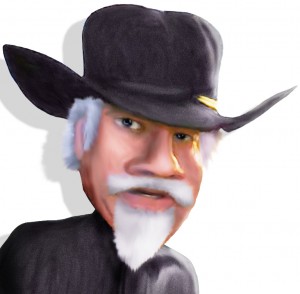November 2, 2017
Just Saying…
 By Q.C. Jones
By Q.C. Jones
Talking Turkey…
Turkey talk in November is almost too cheap and easy. By the time you read, this you will have been bombarded with turkey talk. Recipes, blunderbuss toting pilgrim pictures, grocery store fliers and fancy table top displays will all splash giant gobblers. After ten months of hibernation, the National Turkey Federation springs into action pushing turkey everything. It’s all turkey all the time. As I sit in my darkened hovel pounding out this piece, I can almost imagine turkey tycoons plotting out the final strategy for a pork and beef free Turkey Day.
But, I have a different story. Actually, a story based on a recent trip to the desert Southwest of New Mexico and Colorado. A pre-Columbian (and pre-Pilgrim) story of ancient people covered over with a rich turkey gravy and possibly featuring some cornbread stuffing.
While driving through the high desert mountains from Santa Fe New Mexico to Denver, my lovely bride and I saw a sign post for the Pecos Valley Historic District. Like many of the obscure attractions in this part of the country, the “nearby” district turned out to be located down miles of twisty, two lane back roads. But the imaginary image of Pecos Pete stirred my mind, and my love wanted to stretch her legs. Further and further we traveled the 17 miles of mountain valleys to the small town of Pecos, New Mexico. Expecting surprise and not much else, we learned that Pecos lies between Sangre de Cristo Mountains and the flat-topped Glorieta mesa and is the natural passageway between the Great Plains and the Rio Grande valley.
This passageway has made the valley important for thousands of years. The site turned out to be the locale of the “Gettysburg of the West” during the civil war in March of 1862, as Confederate forces attempted to break the Union hold on the trans-Rocky west. But our discovery goes back several hundred years earlier.
Visiting the Pueblo ruins of Pecos Valley in Norther New Mexico, we stumbled onto a strange and mysterious fact. The site is all that remains of a five story adobe and stone
structure on a high plateau overlooking a scenic valley. Actually, you can see for miles in all directions. The earliest records indicate the first Spanish explorers discovered over 2,000 inhabitants living in the settlement. And, hundreds of years before the first Thanksgiving, the native Pueblo’s loved turkey.
While a good portion of the Pueblo diet consisted of corn, squash and beans, one of the main sources of protein came from turkey meat and eggs. Apparently, the group started off as hunters and gained protein from the animals of the region, but with 2,000 mouths to feed the wild game soon got pretty scarce, so enter the turkey.
I always thought of turkeys as wild birds hunted by the natives, later by the Europeans and today by the quarter million members of the Wild Turkey Federation. So I asked Ranger Rick the question, “Were the turkeys wild or domesticated?” Here’s a short run down on the history.
Our famous bird was actually domesticated by the Mayans around 800 BC. We don’t know if domesticated birds were traded with other indigenous peoples or domesticated a second time, but by 200 BC the birds were showing up across American Southwest. But by the time of Columbus (who sailed the ocean blue in 1492), turkeys were distributed throughout the farming villages of the Pueblo peoples.
How do we know this? Well, it seems the best records are of turkey feathers used for decorations and blankets throughout the region. Apparently, turkey down came in useful during the cold desert nights. Turkey bones were fashioned into a good many tools and appliances by the native peoples for centuries before the meat became so prevalent. But let’s get back to the meat of the matter.
According to early accounts the Aztecs staged a turkey festival every 200 days and traded approximately 900 – 1,000 birds daily in their markets. Mayan royal feasts included turkey wrapped in corn tortillas. By the time conquistadors arrive in the Americas, turkey had become the staple meat of Mayans, Aztecs, Incas and other indigenous peoples. Both Cortes and Columbus tasted turkey and found the meat tasty enough to take a few specimens to Spain. Soon turkey was popular amongst the European aristocracy due to its less stringy texture. Up to that time, nobility ate peacock (sorry NBC) and pheasant, both of which have stringy flesh.
From Spain, turkey spread to France, Italy and the rest of Europe. It was considered to be a delicacy. For example, one of the first English mentions of turkey as a celebratory roast was in Charles Dickens’ A Christmas Carol. Poor Bob Crachit and his family are about to dine on greasy goose meat for Christmas dinner, until an enlightened Ebenezer Scrooge intervenes and brings them a turkey as big as a young
boy. Quite frankly, I would have rather had ham, but that’s another story.
Finally, if you must have turkey, may I suggest a return to the Mayan specialty, turkey mole? This fine dish combines a mixture of chocolate, pumpkin seeds and various hot peppers. The whole thing keeps the turkey from getting dried out. And, I would rather eat a 20 year old army boot than dried out turkey.
Just saying…


